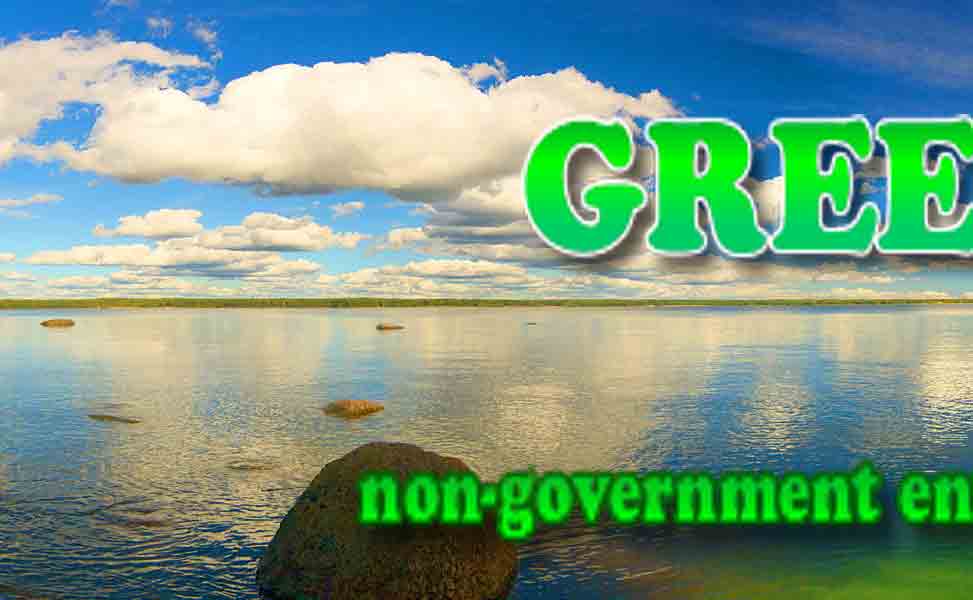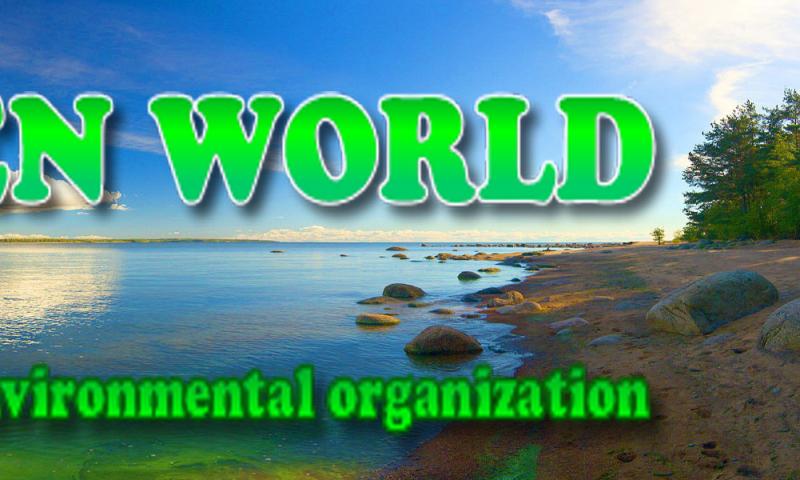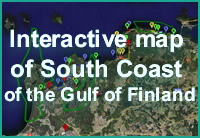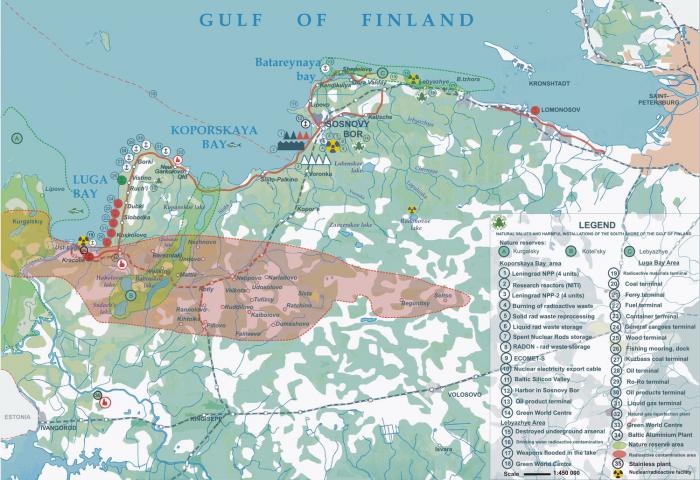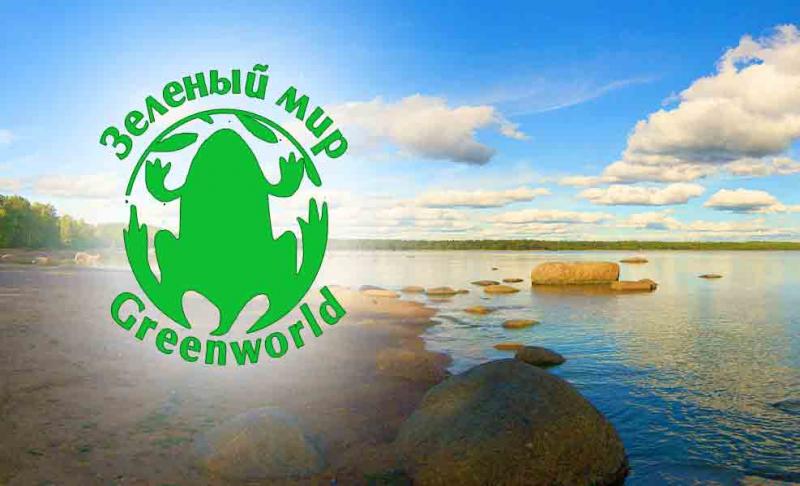
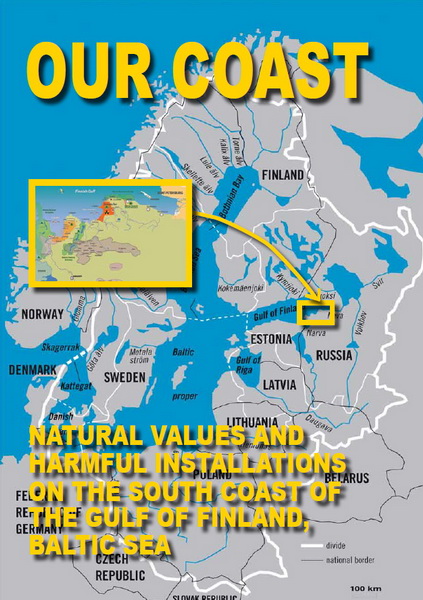 |
The South Coast of the Gulf of Finland |
|---|---|
| Natural Values and Harmful Installations |
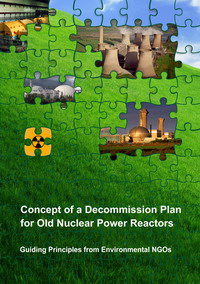 |
Concept of a decommission plan for old nuclear power reactors |
|---|---|
| Guiding Principles from Environmental NGOs |
Natural Values and Harmful Installations of the South Coast of the Gulf of Finland Baltic Sea
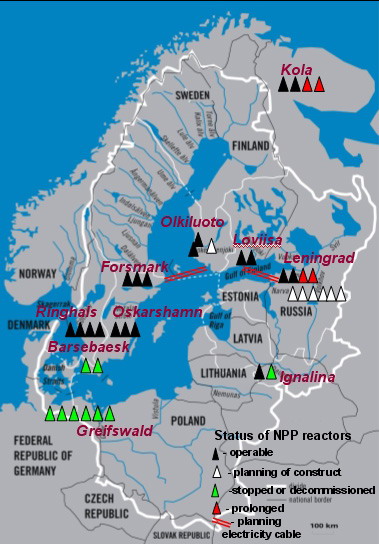 One hundred and eighty kilometers of the South Coast of the Gulf of Finland (SCGF) between the Narva River (Russia-EU border) and St. Petersburg connect unique natural complexes. It has three nature-protected territories, reserves Kotelsky, Kurgalsky Peninsula and Lebiazhy. Two last-mentioned are wetland reserves having international status.
One hundred and eighty kilometers of the South Coast of the Gulf of Finland (SCGF) between the Narva River (Russia-EU border) and St. Petersburg connect unique natural complexes. It has three nature-protected territories, reserves Kotelsky, Kurgalsky Peninsula and Lebiazhy. Two last-mentioned are wetland reserves having international status.
Indigenous population of SCGF, Russians and Ingermanland people (Finno-Ugric tribes Izhora and Vod’) lived in balance with nature, their traditional activities were fishing and agriculture.
All South Coast Rivers and bays are the habitat and spawning places for tens of commercial and rare fish species, including Baltic salmon, lamprey, Baltic herring …
The SCGF has a significant geothermal anomaly, which stretches along it. The rock temperature at the depth of 2 km can be as high as 70°С. The thermal anomaly has the area of 13.000 km2; its expert estimate is about 7.5 bln. t of conventional fuel. It is the subsurface sea of renewable energy.
New socio-economic situation came into being after the Soviet Union disintegrated and East European countries entered the European Union. A huge port complex started to shape out on the South coast, in Luzhskaya bay, – a transport corridor between Russia and European Union. The export of non-renewable resources (gas, oil, coal) and electricity is stimulated from Russia to Europe. The Russian side more and more frequently shows the readiness to accept radioactive, nuclear and other waste.
Operation of Leningrad NPP (LNPP), the largest in the Baltic Region, start of LNPP-2 construction and establishment of new terminals in Luzhskaya bay stimulate the development of power-intensive industrial projects on the SCGF.
Absence of democratic traditions of the public participation in making decisions about siting hazardous production facilities promotes their development on the SCGF. Changes in the Russian legislation in 2007 have essentially restricted the possibility of society to influence this development scenario.
Map of Natural Values and Harmful Installations
of the South Coast of the Gulf of Finland Baltic Sea
NATURAL VALUES
A KURGALSKY PENINSULA (KP) – wetland reserve of international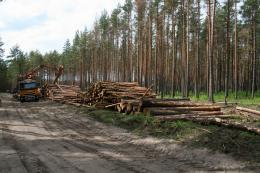 value, protected by the RF laws and international Ramsar Convention. Area of the reserve is about 60.000 ha. It is the model area of coastal landscapes typical of the South Coast of the Gulf of Finland. The area has the richest biodiversity in Leningrad Oblast. More than 200 species have been entered into the Red Books.
value, protected by the RF laws and international Ramsar Convention. Area of the reserve is about 60.000 ha. It is the model area of coastal landscapes typical of the South Coast of the Gulf of Finland. The area has the richest biodiversity in Leningrad Oblast. More than 200 species have been entered into the Red Books.
Protected are the nesting and resting places of local and migrating water birds, as well as the lairs places of grey seals. The coastal shoals host fish spawning places; they also are the zone of seawater self-purification.
It is prohibited in KP: to hunt on the territory of KP around the year and to fish from 15 April till 15 June.
Unsolved problems of KP:
- Higher risk of the coastal waters contamination with oil products resulting from intensified port development and shipping in Luzhskaya bay;
- Increased factor of disturbance for the colonies of fish and seals and higher risk of forest fires due to the growing recreation load accompanying the construction of ports in Luzhskaya bay;
- Depleted biodiversity as a consequence of industrial logging on the KP territory (40 th. m3 in 2007);
- Wildlife (animals and birds) damaged by the bombing exercise at the military shooting range located on the KP territory.
There is a threat of losing natural values of Kurgalsky peninsula due to the inefficient environmental management of this territory.
B KOTELSKY – complex reserve of regional level having the area of more than 12.000 ha. It comprises picturesque lakes of glacier origin with exchangeable water:  Kopanskoe, Glubokoe, Babinskoe, Khabolovo, Sudachie, as well as the part of the Gulf of Finland.
Kopanskoe, Glubokoe, Babinskoe, Khabolovo, Sudachie, as well as the part of the Gulf of Finland.
The lakes have rich fish population - perch, pike, roach, carp and others. The Peypia stream flowing from Lake Kopanskoe has Baltic trout and European pearl oyster.
Forests around the lakes are the habitat of elks, roedeer, hogs, bears, foxes and badgers. Rare bird species can be seen here: grey crane, golden eagle, sea-eagle, fish-hawk and others. Banks of the lakes are the favorite recreation place for people who come here for the rich harvest of berries and mushrooms.
It is prohibited in Kotelsky: any tree felling in the reserved area, grass burning and camp fires outside organized sites. Car parking is forbidden off the official roads, also in the water protection zone of lakes and rivers, excluding the designated locations.
Unresolved problems of Kotelsky:
- unavailability of public information about its boundaries and rules of behavior on this nature protected territory;
- absence of efficient enforcement of the environmental protection laws, norms and rules acting on the Kotelsky territory;
- low level of environmental awareness of campers and holiday-makers (fires, household garbage, dumps and unauthorized car parking);
- irresponsible strategy of regional authorities to develop hazardous and “dirty” projects on the adjacent territories – aluminium plant, nuclear power plant with cooling towers, and a number of others.
C LEBIAZHY – wetland reserve of international value protected by the RF laws and international Ramsar Convention, which protect water birds migrating along the  White Sea – Baltic Sea route. Area of the reserve is 6.300 hectare. Up to 20 thousand swans and other water birds stop there for rest during the spring and autumn migration. Dozens of bird species are entered in the Red Books.
White Sea – Baltic Sea route. Area of the reserve is 6.300 hectare. Up to 20 thousand swans and other water birds stop there for rest during the spring and autumn migration. Dozens of bird species are entered in the Red Books.
In Lebiazhy it is prohibited: to hunt, to build, to disturb coastal plant and animal communities, use motor boats after the ice melts until 25 May and from 15 September till the sea freezes. In the period of 20 April - 15 July it is also forbidden to visit reed-beds; driving and use of boats is restricted to roads and permitted waterways.
Unsolved problems of Lebiazhi:
- higher risk of coastal water pollution with oil products, as the shipping on the Gulf of Finland becomes more intensive;
- more pronounced recreation load combined with the simultaneous reduction (approximately 2 times) of the Lebiazhy reserve territory. The territories, which were cut from the reserve, are attracting potentially hazardous projects (oil port in Batareynaya bay), building of cottages along the shoreline;
shoreline erosion caused by the excavation of sand on the sea shoal in front of Lebiazhy (London sand-shoal) and unrestricted entrance of cars with holiday-makers.
There is a threat of losing natural values of Lebiazhie due to the inefficient territory management.
HARMFUL INSTALLATIONS OF KOPORSKAYA BAY :
1 LENINGRAD NPP (LNPP) – the largest nuclear power plant on the Baltic Sea (4.000 MW) having four RBMK-1000 (Chernobyl design) reactors, which use the seawater at the  flow-rate of 200 m3/sec.
flow-rate of 200 m3/sec.
Main environmental impact during the operation without accidents:
- Thermal pollution of sea ecosystems causes accelerated eutrification (or ecological ageing of the sea), depresses sea fish spawning, stimulates the growth of cyanobacteria and enhanced activity of toxicants.
- Mass fish perishing (numbers up to hundreds millions) in the NPP cooling system, which takes the gulf water without the fish protection barrier.
- Emissions of radioactive gases into the atmosphere and its changed electric conductivity lead to negative changes in the atmospheric processes.
- Every year decade’s tons of fish, which was bread in the warm water of the LNPP discharge channel, are supplied to shops of the region; its consumers are not informed about the fish origin.
Frequency of severe accidents with RBMK-1000 reactors, which result in trans-boundary pollution, is once per 100 years. Accidents at LNPP take place once every three years. During the accident of 1975 a fuel assembly got burned, one of the 1693 reactor channels lost its integrity. In accordance with expert estimation up to 1.5 mln. Curie was released into the ambient air. The background gamma level in the area grew by hundred times. Local population was not informed about the health threat. The radioactive contamination registered in Finland.
LNPP Unsolved problems:
- Absence of acceptable solutions for the long-term isolation of spent nuclear fuel containing Plutonium-239, which continues to be hazardous for the environment during hundreds of thousand years.
- Lack of money (up to $ 3 billion) for the safe plant decommissioning after its lifetime expires.
- Absence of acceptable technologies for reprocessing 6.800 t of radioactive Carbon (14С) present in the graphite cladding of LNPP reactors. It is one of the challenges to be faced at the plant decommissioning. The half-life of this noxious element is 5.400 years. Absence of solutions means that the hazardous components of reactors will stay on the Baltic seashore after the plant closure. The period of their dangerous presence will last until a new technology for their efficient isolation from the living nature is developed.
- Unavailability of independent monitoring of nature and people’s health in the region subjected to the most dramatic impact of nuclear facilities.
2 NUCLEAR SUBMARINE REACTORS of different types developed at the ALEXANDROV RESEARCH INSTITUTE OF NUCLEAR TECHNOLOGY (NITI) are experimentally tested in the institute. 
Main environmental impact during the operation without accidents: cooling water from the reactors, which is discharged into the Baltic Sea, is the main regional supplier of radionuclides Co60, Mn54, Cs137.
NITI most serious accidents:
- The core was molten and a reactor top lost its integrity (1972);
- Thermal explosion (1979) of a component in the reactor emergency cooling system (water tank) resulted in the building demolition. Two persons were killed.
Unsolved problems: unavailability of public information about the normal-operation and accidental impact from nuclear facilities (operating and developed) on the health of nature and people and absence of open discussions of programs for safe decommissioning of old reactors and solution of spent nuclear fuel problems.
3 LENINGRAD NPP-2 (LNPP-2) with first two reactors VVER-1200  (1200 MW), which cost $ 6 billion, is under construction next to the old LNPP. It is planned to build 6 power units.
(1200 MW), which cost $ 6 billion, is under construction next to the old LNPP. It is planned to build 6 power units.
Main impact on the environment: daily release of seawater after 150m-high 4 cooling towers (for two power units) is up to 100.000 t. This will lead to the soil salinization in the area. Acidic fallouts are possible due to the reaction between emissions from LNPP-2 cooling towers and oxides of nitrogen, phosphorus, fluorine, etc., which get into the atmosphere from Estonian power plants using oil-shale as fuel; combined with emissions from aluminium, silicon and other plants planned in the neighborhood. It is also possible that cooling towers will disperse hazardous sea pollutants and stimulate radioactive fallout having the source at LNPP-1. This can cause the damage to pine forests, residents of Sosnovy Bor and thousands gardening communities.
LNPP-2 is a much more expensive source of power than refurbished and reoriented to the steam-gas cycle heat and power stations of the region, which operate on gas. Their modernization could bring the energy output in the region to a higher level (without increased gas consumption) than a possible LNPP-2 production.
Unsolved problems:
- Absence of technological solutions for the long-term immobilization (reprocessing) of spent nuclear fuel.
- No systematic analysis of safety provisions for the new and old NPPs taking into account their simultaneous operation.
- No market for economic competition between different power sources and no ways of public influence on the decisions about the power sources.
4 INCINERATION UNIT FOR RADIOACTIVE WASTE (RW) of LNPP was 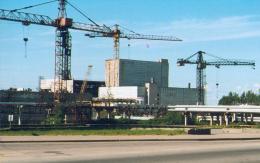 brought to the stage of construction on the LNPP territory without the mandatory environmental examination. It is planned to burn hundreds tones of incinerable radioactive waste per year.
brought to the stage of construction on the LNPP territory without the mandatory environmental examination. It is planned to burn hundreds tones of incinerable radioactive waste per year.
5 REPROCESSING UNIT FOR SOLID RADIOACTIVE WASTE (SRW) of LNPP was brought to the stage of budgeting and construction on the LNPP territory without the mandatory environmental examination. It is planned to reprocess more 1000 m3 of SRW/year.
6 STORAGE OF LIQUID RADIOACTIVE WASTE (LRW) of LNPP is on the LNPP territory; it was designed to isolate LRW from the environment in special containers. 18.500 m3 of LRW has been accumulated after 33 years of operation.
7 TEMPORARY STORAGE OF SPENT NUCLEAR FUEL (SNF) of LNPP is used to cool and isolate from the environment more than 30 thousand fuel assemblies spent in the reactor (4.000 t). Up to 20 t of supertoxic Pu239 (half-life period of 24 thousand years), which SNF contains, will require its eternal isolation from the environment. There are no environmentally and economically acceptable technologies for its processing or safe disposal.
The workshop for cutting of SNF and its immobilization in ferro-concrete containers started to construct without the environment Impact assessment some years ago. The site for SNF dry storage will be 100 m from the Baltic Sea.
8 SPECIALIZED PLANT RADON – regional facility for North-West  Russia, which stores solid (more than 60.000 m3) and liquid (1.200 m3) medium- and low-level radioactive waste. The RW is kept for temporary storage in surface concrete buildings-boxes. The facility is in operation since 1962. The exposure dose rate near walls of some storage facilities is 200 times higher than the background level.
Russia, which stores solid (more than 60.000 m3) and liquid (1.200 m3) medium- and low-level radioactive waste. The RW is kept for temporary storage in surface concrete buildings-boxes. The facility is in operation since 1962. The exposure dose rate near walls of some storage facilities is 200 times higher than the background level.
After water extinguishing of fires (1976, 1979), which spontaneously started in the storage facilities, the groundwater near them got contaminated with biological contaminants H3, Cs137, Sr90 and supertoxic Pu239.
Unsolved problems: Unavailability of storage space for the disposal of new RW, also in case of an emergency situation or decommission process at LNPP.
9 PLANT FOR MELTING METALLIC RADIOACTIVE WASTE ECOMET-S – the 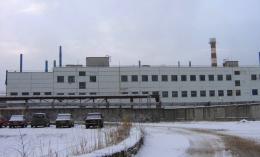 largest in Europe (6.000 t/year). The plant belongs to the private company; it is in operation on the territory of RADON plant and LNPP since 1996 without the mandatory environmental examination. The company brings radioactive metal for reprocessing from other regions of Russia. It is planned to increase its capacity to 10.000 t and import radioactive metal from other countries.
largest in Europe (6.000 t/year). The plant belongs to the private company; it is in operation on the territory of RADON plant and LNPP since 1996 without the mandatory environmental examination. The company brings radioactive metal for reprocessing from other regions of Russia. It is planned to increase its capacity to 10.000 t and import radioactive metal from other countries.
ECOMET-S supplies the processed metal to the world market without informing about its origin and restrictions for use.
Main impact on the living environment during the normal operation – radionuclide emissions into the atmosphere. Geneticists have registered the frequency of cytogenetic malformations in needles and seeds of pine trees growing near ECOMET-S, which is 2.8 times higher than 30 km to the East.
Accidents: repeated explosions in the melters resulted in deaths (3 persons in 2005) and disabilities of operators.
Unsolved problems:
- Absence of independent control of the metal supplied to the world market; users get no information about the source of its production.
- Concentration and storage of RW from all over Russia on the Baltic coast.
10 CABLE FOR THE EXPORT OF NUCLEAR ELECTRICITY ON THE BALTIC SEABED FROM LENINGRAD NPP to the countries of the Baltic Region (Finland, Sweden, Estonia) is promoted by 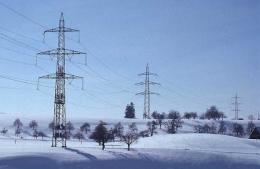 BaltEnergo, a daughter company of Rosenergoatom. The project is supported by the government of Russia; it is developed in absence of the mandatory environmental examination. Cost of the project € 300 mln. BASEL, the association of Swedish industrial consumers of electricity, is ready to pay €4 billion for the electricity during 15 years. Talks about the export of nuclear electricity are in progress in Estonia.
BaltEnergo, a daughter company of Rosenergoatom. The project is supported by the government of Russia; it is developed in absence of the mandatory environmental examination. Cost of the project € 300 mln. BASEL, the association of Swedish industrial consumers of electricity, is ready to pay €4 billion for the electricity during 15 years. Talks about the export of nuclear electricity are in progress in Estonia.
Hazards of the project: LNPP power unit, which has the expired design time limit, will produce energy for export. It is equivalent to the yearly import of about hundred tons of SNF and high-level waste to Baltic Russia, the problems of long-term safe disposal of which have not been solved. The project will contribute to a further lifetime extension of an old LNPP power unit, which does not meet the safety requirements of the countries, to which its energy will be exported.
11 BALTIC SILICON VALLEY – It is planned to develop a project  for the world-largest chemical plant for the production of polycrystalline silicon (5000 t/year with a perspective for 20.000 t/year) in the town of Sosnovy Bor. Cost of the project is $370 mln. It has been approved by the regional and federal authorities and planned for implementation in the period of 2008 - 2012 on a 40 ha site. The power-intensive technology requiring 500 MW (half of the RBMK-1000 reactor capacity) was sited by project developers close to Leningrad NPP.
for the world-largest chemical plant for the production of polycrystalline silicon (5000 t/year with a perspective for 20.000 t/year) in the town of Sosnovy Bor. Cost of the project is $370 mln. It has been approved by the regional and federal authorities and planned for implementation in the period of 2008 - 2012 on a 40 ha site. The power-intensive technology requiring 500 MW (half of the RBMK-1000 reactor capacity) was sited by project developers close to Leningrad NPP.
Its raw material is metallurgical silicon, which will be shipped from the Ural region of Russia, also imported from Norway and Brazil.
The products will be used by electronic industry and solar engineering. The project is implemented by a group of companies including OAO ‘Baltic Silicon Valley – International project PoliSiL’ and JSC ‘Project Engineering Company’.
Today strategic partners in the project are FGUP ‘Krasmash’, RF Sberbank, Concern ‘Titan-2’, FGUP “Efremov NIIFA”, JSC ‘Kriogenmash’, and others.
Hazards of the project: atmospheric emissions of hydrogen chloride will result in acid rains and growth of cancerous diseases.
12 PORT IN SOSNOVY BOR. ZAO “Seaport of Sosnovy Bor” is 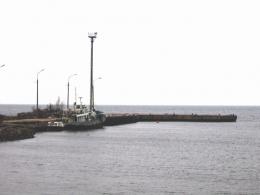 planning to establish passenger communication with Peterhof and St. Petersburg. Further on, the Group of Companies “Alien”, which promotes the project, is planning to develop ferry communication with Vyborg and Kotka (Finland). It is planned to complete the essential bottom dredging operations before 2009. A project for developing cargo terminals having the annual capacity of 4 mln. t is discussed.
planning to establish passenger communication with Peterhof and St. Petersburg. Further on, the Group of Companies “Alien”, which promotes the project, is planning to develop ferry communication with Vyborg and Kotka (Finland). It is planned to complete the essential bottom dredging operations before 2009. A project for developing cargo terminals having the annual capacity of 4 mln. t is discussed.
Hazards of the project:
- Devastation of spawning places for Baltic herring and other commercial fish species caused by dredging and subsequent navigation;
- Risk of compete loss of the ‘fish spawning stream’ status for the Kovash River;
- Risk of emergency oil spill getting into the Leningrad NPP cooling systems, which pump up to 200 m3 of seawater every second. LNPP water intakes are located at a 5 km distance from the planned port.
13 PORT IN BATAREYNAYA BAY for the export of 15 mln. oil  products ($ 600 mln.) was formally founded on 19 July 1997 on the territory of wetland reserve “Lebiazhie” having the international status. The project of “Surgutneftegaz” Company was supported by the Governor of Leningrad Oblast and Government of Russia as a political alternative to the ports built by the USSR, which after its collapse have become a component of Lithuania and Estonia transport system.
products ($ 600 mln.) was formally founded on 19 July 1997 on the territory of wetland reserve “Lebiazhie” having the international status. The project of “Surgutneftegaz” Company was supported by the Governor of Leningrad Oblast and Government of Russia as a political alternative to the ports built by the USSR, which after its collapse have become a component of Lithuania and Estonia transport system.
The territory of Lebiazhie reserve was cut in order to provide for the oil port construction outside the boundaries of the nature-protected territory. In spite of the governmental pressure “Surgutneftegaz” never started the port development, but there has been no formal cancellation of the project.
If the project is resurrected, the port operation will destruct the resting places of swans and other migrating water birds.
14 GREEN WORLD INFORMATION CENTRE (GWIC) IN SOSNOVY BOR.
The main goals of GW activities:
- Obtaining, analysis and distribution of environmental information and promotion the sustainable development in the Region;
- Involving the residents and authorities of the Region in activities for nature protection and sustainable style of life;
- Saving marine ecosystem of the Baltic Sea, the unique nature reserves of the South Coast of the Gulf of Finland;
Main objects monitored by GW
- Lebyazhiy (Swans), Kurgalsky Peninsula, - the international Ramsar Convention sites and Kotelsky Natural Reserve;
- The nuclear facilities of Sosnovy Bor with the biggest Nuclear Power Plant in the Baltic Sea region.
GWIC head in Sosnovy Bor - Oleg Bodrov
Phone/fax.: +7 81369 72991
E-mail: bodrov@greenworld.org.ru
http://greenworld.org.ru, http://decomatom.org.ru
Address for the visitors: office 12, Solnechnaya Street 18, Sosnovy Bor, Leningrad oblast.
ENVIRONMENTAL HOTSPOTS OF LEBIAZHIE
15 EXPLODED (19 AUGUST 1918) UNDERGROUND ARSENAL with  ammunition of the Krasnaya Gorka Fort. In 2006-2007 a partial demining of storages with unexploded shells of 10-inch cannons was undertaken. Still, hundreds of tons of unexploded shells of 6-inch guns dating back to the World War I continue to stay under the rubble. These shells contain a very dangerous explosive picric acid (shimoza, milenite). Buried shells containing phosgene (chemical weapon) are likely to stay there. Such shells have been found twice.
ammunition of the Krasnaya Gorka Fort. In 2006-2007 a partial demining of storages with unexploded shells of 10-inch cannons was undertaken. Still, hundreds of tons of unexploded shells of 6-inch guns dating back to the World War I continue to stay under the rubble. These shells contain a very dangerous explosive picric acid (shimoza, milenite). Buried shells containing phosgene (chemical weapon) are likely to stay there. Such shells have been found twice.
16 RADIOACTIVE CONTAMINATION OF THE SYSTEM FOR DRINKING WATER SUPPLY IN TOWNSHIP LEBIAZHIE (5000 inhabitants) was detected by chance in 1989. Tens of years before that, this groundwater contaminated with radium (Ra226 и Ra228) was consumed by people in dangerous concentrations. Without knowing about it employees of the local water station were exposed to 11 rem/year dose rates, which is higher than the exposure of NPP employees.
groundwater contaminated with radium (Ra226 и Ra228) was consumed by people in dangerous concentrations. Without knowing about it employees of the local water station were exposed to 11 rem/year dose rates, which is higher than the exposure of NPP employees.
In 1990 Lebiazhie was connected to a different drinking water system, but it continues to use old pipes, deposits in which have the capacity of equivalent dose 15 µSv/h (100 background levels). After the frequent failures at the main water pipe are rectified, inhabitants get the muddy water enriched with radionuclides.
In order to improve the safety standard of Lebiazhie residents it is necessary:
- provide local community with leaflets on health protection measures in the current conditions;
- replace 6 km of the township pipes contaminated with radionuclides;
- replace water supply and sewage pipes in houses;
- if necessary, dispose of the discarded contaminated pipes in the RW storage;
- organize health monitoring of Lebiazhie residents;
- develop proposal for the governmental compensation to the people who suffered due to this environmental hazard.
17 TRAINLOADS OF AMMUNITION DROWNED IN BOLSHEIZHORSKOE LAKE during World War II. The ammunition evacuated from Tallinn naval base was drowned in the lake under the threat of capture by advancing Nazi troops in the second half of 1941.
of capture by advancing Nazi troops in the second half of 1941.
The lake is guarded by the military. It is necessary to evaluate the risk of possible negative consequences for the health of people and wetland reserve Lebiazhie in case of detonation, also in the conditions of natural deterioration of shells, which have stayed in water for more than 60 years. The Baltic Sea and Lebiazhie reserve are a few hundred meters away from the lake with submerged AMMUNITION.
18 GREEN WORLD CENTER OF ECOLOGY AND CULTURE IN TOWNSHIP LEBIAZHIE carries out the nature protection and history-and-culture education programs. 
Some, most relevant projects with the Center participation:
- reconstruction of historically authentic female costumes of indigenous population of the South Coast of the Gulf of Finland (supported by the Consulate General of Finland in St. Petersburg, 2005);
- prevention of sale of historical relics of the Krasnaya Gorka Fort (together with Lebiazhie deputies and representatives of political parties from Sosnovy Bor);
- establishment of the local nature protected territory “Bianki meadow”.
Address of the Center: Stepanjana Street 13, Lebiazhie high school, township Lebiazhie, Leningrad Oblast, Russia
Head of the Center: Alexander Senotrusov, mob. tel. +7 95000828333
FACILITIES OF LUZHSKAYA BAY: POTENTIAL ENVIRONMENTAL HAZARD Ust’-Luga Harbour
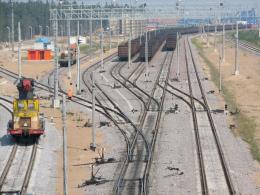
19 TERMINAL FOR THE IMPORT OF NUCLEAR AND RADIOACTIVE WASTE. The plans adopted by the Russian Government October 14, 2003, No. 1491- r.
The plans adopted by the Russian Government October 14, 2003, No. 1491- r.
20 JSC ROSTERMINALUGOL' COAL TERMINAL. Throughput capacity is  4 millions t/year. The construction will be finished in 2009. Throughput capacity will reach 12 million t/year.
4 millions t/year. The construction will be finished in 2009. Throughput capacity will reach 12 million t/year.
21 FERRY TERMINAL. Throughput capacity is 2.3 millions t/year.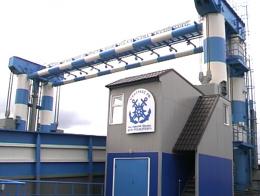 The construction will be completed in 2007.
The construction will be completed in 2007.
22 BUNKERING TERMINAL 5 millions tones per year. Under construction. The construction will be completed in 2009.
23 CONTAINER TERMINAL 3 millions TEUs. The construction will finish in 2008.
24 GENERAL CARGO TERMINAL 4,5 under construction. The construction will finish in 2010.
25 FOREST TERMINAL for the export of logs has been built in  the mouth of the Luga River. The terminal belongs to the Factor Company. Supported by regional authorities, the company carries out industrial logging and export shipments of the forest cut on Kurgalsky Peninsula, the wetland reserve having the international status. In 2007 it is planned to cut and sell 40.000 m3 of indigenous forest protected by the legislation of RF, Leningrad Oblast and international Ramsar Convention.
the mouth of the Luga River. The terminal belongs to the Factor Company. Supported by regional authorities, the company carries out industrial logging and export shipments of the forest cut on Kurgalsky Peninsula, the wetland reserve having the international status. In 2007 it is planned to cut and sell 40.000 m3 of indigenous forest protected by the legislation of RF, Leningrad Oblast and international Ramsar Convention.
26 FISHING QUAY, DOCK of the fishermen collective farm  Baltica. Fishing is the main occupation of the small indigenous nation, Izhora people, the traditional trades and lifestyle of which are to be protected by the RF Act “On the guarantees of rights of small indigenous nations of the Russian Federation" of 30 April 199, N 82-FZ. Deep dredging for the Port of Ust-Luga disturbs and spreads toxic and radioactive bottom sediments contaminated by the Chernobyl fallout. This destroys spawning fields, contaminates the plankton and fish of Luzhskaya Bay. It undermines the traditional occupation of fishing, which was pursued by local inhabitants for centuries. The fishing fleet of Baltica collective farm has shrunk by dozens of times. Fishing is at the brink of extinction.
Baltica. Fishing is the main occupation of the small indigenous nation, Izhora people, the traditional trades and lifestyle of which are to be protected by the RF Act “On the guarantees of rights of small indigenous nations of the Russian Federation" of 30 April 199, N 82-FZ. Deep dredging for the Port of Ust-Luga disturbs and spreads toxic and radioactive bottom sediments contaminated by the Chernobyl fallout. This destroys spawning fields, contaminates the plankton and fish of Luzhskaya Bay. It undermines the traditional occupation of fishing, which was pursued by local inhabitants for centuries. The fishing fleet of Baltica collective farm has shrunk by dozens of times. Fishing is at the brink of extinction.
GORKI EAST HARBOR AREA
27 BALTIC KUZBASS COAL TERMINAL planned.
28 OIL TERMINAL of North-West alliance, 10 millions tones/year, under construction.
29 RO-RO TERMINAL in Gorky-East harbor area planned in Vistino. Local Izhora fishermen and other residents of the village will be barred from entering this part of the coast.
Local Izhora fishermen and other residents of the village will be barred from entering this part of the coast.
30 OIL PRODUCTS TERMINAL planned
31 LIQUEFIED GAS TERMINAL planned
32 PLANT FOR GAS LIQUEFACTION planned for export tanker 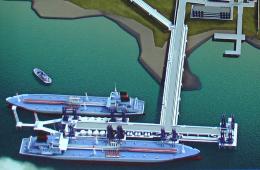 shipments of gas via the terminal to be developed in the West part of Koporskaya Bay.
shipments of gas via the terminal to be developed in the West part of Koporskaya Bay.
33 GREEN WORLD INFORMATION CENTRE (GWIC) in Vistino.
The main goal of GWIC activity in Vistino is: 
- obtaining, analysis and distribution of information about the new terminal projects in Luga bay;
- involving the residents and authorities of the Region in activities for protection of nature and sustainable stile of life Indigenous population of the South coast of the Gulf of Finland;
- saving marine ecosystem of the Baltic Sea, the unique nature reserves of the south coast of the Gulf of Finland;
GWIC address: Izhorskaya Street, Community Centre Vistino village, Leningrad Oblast, Russia
Head of the Center: Valentina Konstantinovna Petrova,
phone/fax +7 81375 67119,
contact person Eugenia Baula, mob. phone +7 921 392 1973
34 BALTIC ALUMINUM PLANT 540.000 tonnes/year planed by Russian-UK business near the Kurgalsky Peninsula and Ust-Luga harbor. The project of $1.8 billion is promoted by the Baltic Aluminium Company, which belongs to the Quanta Research Ltd. Registered in Britain and Virginia 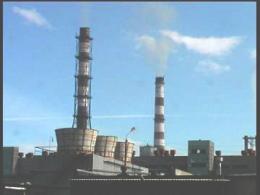 Isles. The Baltic Aluminium Plant (BAP) is registered in settlement Kotelsky of Leningrad Oblast, building 34. It should be mentioned that Kotelsky has no building with this number. It is assumed that raw materials will be imported from Africa or Australia via the port of Ust-Luga, and the finished products sold on the London exchange of non-ferrous metals. At present only 13% of aluminium produced in Russia is sold in the country, the rest is exported. Main reason for starting the aluminium production in this region is the vicinity of the port and Leningrad NPP.
Isles. The Baltic Aluminium Plant (BAP) is registered in settlement Kotelsky of Leningrad Oblast, building 34. It should be mentioned that Kotelsky has no building with this number. It is assumed that raw materials will be imported from Africa or Australia via the port of Ust-Luga, and the finished products sold on the London exchange of non-ferrous metals. At present only 13% of aluminium produced in Russia is sold in the country, the rest is exported. Main reason for starting the aluminium production in this region is the vicinity of the port and Leningrad NPP.
Hazards of the project: Fluoride compounds and benz(a)pyrene released into ambient air will pollute the Sista River, the source of water supply for 70 thousand people. Inevitable will be the damage to the Kurgalsky Peninsula and Kotelsky reserves, and spawning places of commercial fish species of the Khabolovka River. Atmospheric emissions from aluminium plant will interact with steam releases from LNPP-2 cooling towers (100.000 t/day) to produce acid rains, which are harmful for pine forests.
GREEN WORLD campaign of protest against the BAP project in the summer of 2007 supported by thousands of citizens living on the South coast of the Gulf of Finland. As a result of this the Administration of Kingisepp Rayon refused to allocate a site for the BAP construction. In this way a third within 5 years attempt to start an aluminium plant between Kurgalsky and Kotelsky reserves, in the area of Leningrad NPP and port of Ust-Luga, has ended in the victory of local community over the hazardous project initiators.
35 STAINLESS STEEL PLANT, planned by Indian company Jindal Stainless Ltd. The project supported by the Governor and Government of Leningrad oblast. It is planned to build the plant in the «Phosphorite industrial zone» of Kingisepp rayon, not far from the Luga River.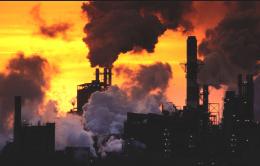 Production capacity of its first stage is 400.000 t of stainless steel ingots per year. Cost of the project is up to $90 million. Vicinity of the port and Leningrad NPP are the main factors attracting Indian business to the South coast of the Gulf of Finland.
Production capacity of its first stage is 400.000 t of stainless steel ingots per year. Cost of the project is up to $90 million. Vicinity of the port and Leningrad NPP are the main factors attracting Indian business to the South coast of the Gulf of Finland.
Hazards of the project: Continued utilization of power from Leningrad NPP will result in the hundreds of tons of nuclear and radioactive waste concentrated in the storages near the Baltic Sea shore. The problem of a long-term disposal of this waste has not been solved, which means its export to future generations.
The cost of all potentially hazardous projects, which were promoted for implementation on the South Coast of the Gulf of Finland during last 10 years, is estimated as 20 billion Euros. It means that more 100.000 Euro will be invested into the environmental devastation of each meter of the 180-km shoreline from the border with Estonia to St. Petersburg.
Along with that, tourism and other business activities, which are oriented on using renewable resources and advantages of unique nature, are restricted because of the so-called border zone status introduced by Russian authorities.
A special permit for visiting this territory is necessary for Russians and citizens of other countries. This creates an illusion that hazardous nuclear facilities located in Sosnovy Bor are protected by frontier troops. Such practice retards the development of non-industrial business on the South Coast of the Gulf of Finland and forces citizens and authorities of nuclear Sosnovy Bor to support and promote hazardous nuclear projects for new jobs.
Baltic States, which neighbor Russia, are, on one hand, interested in getting resources from Russia, on the other, they have no effective legal mechanisms for influencing these trans-national projects. Russia has signed, but not yet ratified the International Convention on Environmental Impact Assessment in a Transboundary context, Espoo, Finland, 25 February 1991.
The new Russian legislation amended in 2007 has practically abandoned the environmental examination of hazardous facilities, as well as their environmental impact assessment. Regional authorities, governors, are not elected, but appointed by the President of Russia. Therefore, regional authorities do not feel their responsibility before residents of the region.
Decisions on the implementation of large projects on the South Coast, which have the trans-boundary impact on the whole Baltic region, are taken on the national level, in Moscow. Municipal authorities and people living on the South Coast of the Gulf of Finland are just notified about the planned projects – that is explained by national interests. At this, the environmental safety and health of people living in the Baltic Region, which are subjected to the impact, are sacrificed to the interests of corporations implementing these hazardous projects.
The fact that members of the Public Chamber, which are to represent the people of the country, are appointed by the President of Russia, has transformed the notion of the public community, independent from authorities and business. Nowadays Russia has not only non-governmental organizations (NGO), civil servants create so-called “governmental” NGOs (GoNGO), business – BiNGO. Mafia creates MaNGOs.
These hybrid forms of public organizations complicate possibilities to influence decisions about hazardous projects using the democratic principles.
That is, the scale of environmental impact from the projects is not equal to the scale of public participation and influence on their deployment.
Therefore, South Coast of the Gulf of Finland becomes a site for implementing large projects having the potential trans-boundary impact on the Baltic Sea Habitat. Such development is not balanced by an adequate possibility for the concerned people to influence these projects and ensure safe living environment conditions.
A possible solution of this problem could be in the uniting the efforts of Russian and Baltic NGOs for the consolidated influence on trans-national companies, using the legislation of the European Union and Russia.
It is necessary to carry out the systematic analysis of the South Coast of the Gulf of Finland and establish the functional zones with nature protected areas and industrial development zones. Such spatial planning activities are, as a rule, carried out by regional authorities together with business community and general public. The interaction of these social groups ensures sustainable (balanced) development of the Baltic Russia.
Oleg Bodrov
NGO Green World,
South Coast of the Gulf of Finland, Russia
